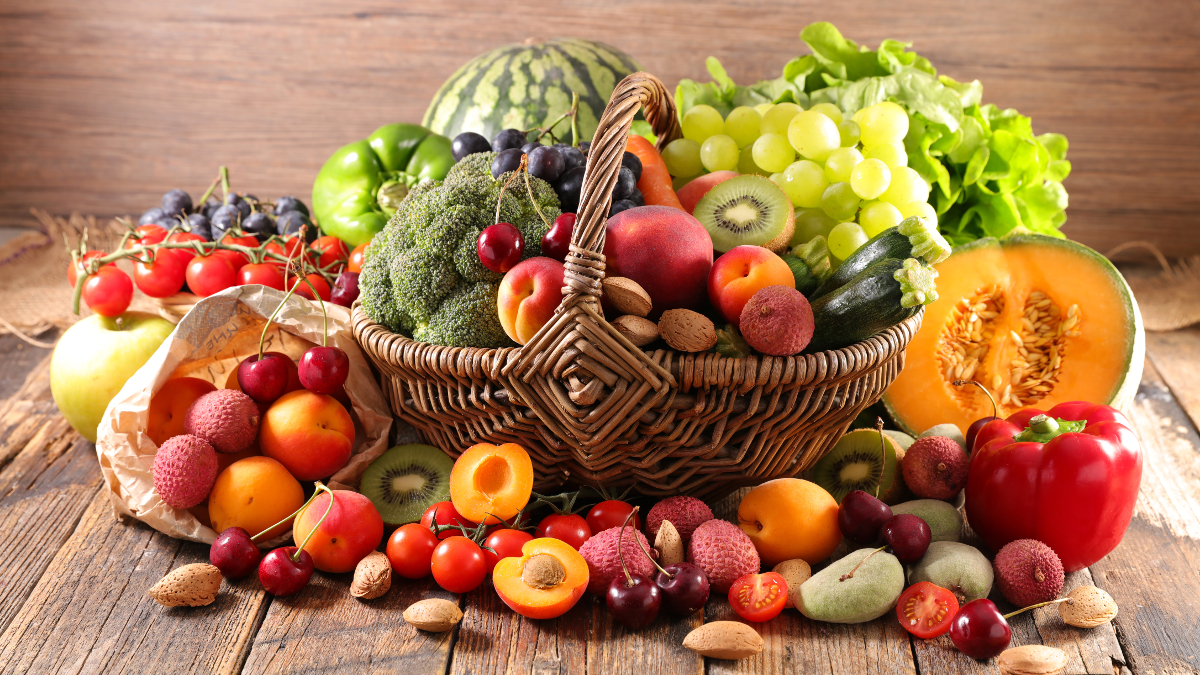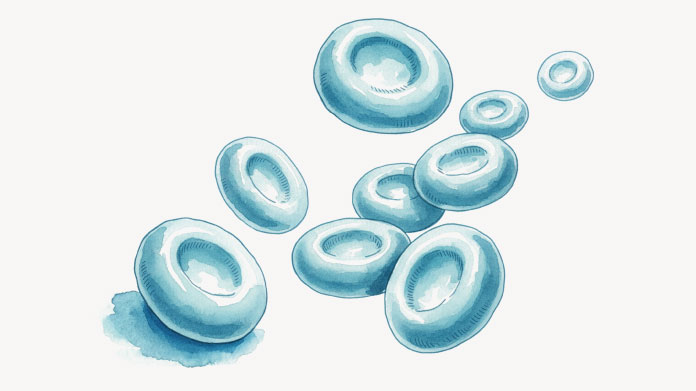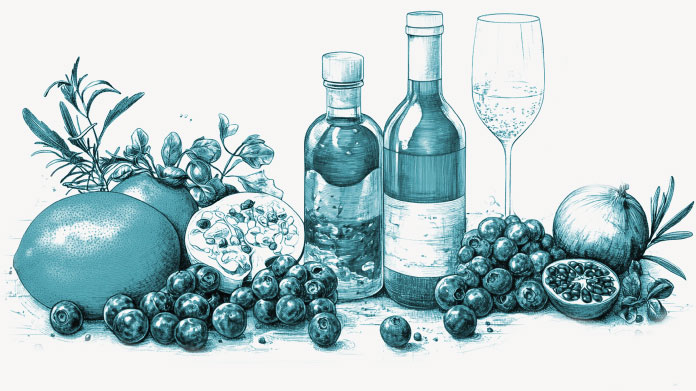Indispensable: the 12 fruits and vegetables with the highest polyphenol content
The polyphenol content of fruits and vegetables is one of the main reasons these foods are so good for our health. But which contain the most? And can you guess which one takes the no. 1 spot?

What exactly are polyphenols?
Polyphenols are organic molecules that exist in the plant kingdom. As their name suggests, these compounds are distinct in having several phenol groups.
Polyphenols thus include simple phenols, coumarins, flavonoids, anthocyanins, lignans...
Several studies have shown that these antioxidant phytonutrients are responsible for many of the health benefits offered by fruits and vegetables.
One French research team has measured the polyphenol concentration of a wide range of common foods (1). Let’s take a look, in ascending order, at the fruits and vegetables with the highest polyphenol content.
Number 12: broccoli
Broccoli, a vegetable of the Brassicaceae cabbage family, contains fibre, carbohydrates, sulphur, potassium, vitamin C...
It also boasts a significant amount of polyphenols, with 98.9mg of GAE/100g (total polyphenols). GAE stands for gallic acid equivalents, gallic acid being a phenolic acid able to exert antioxidant activity.
Broccoli is particularly notable for its high content of the polyphenol kaempferol.
Number 11: dates
Dates are fleshy fruits from desert regions, which are rich in potassium, mineral salts and sugars.
Higher in total polyphenols than broccoli, with 99.3mg of GAE/100 g, dates predominantly contain condensed tannins.
Number 10: shallots
Shallots, the delicious, onion-like vegetables, contain potassium, as well as vitamins B6, B9 and C.
In terms of polyphenols, shallots have 104.1mg of GAE/100g. They also contain flavonoids, particularly the famous quercetin. Try using shallots to add flavour to your salads and sauces, or as an accompaniment to meat… To gain even more from quercetin’s benefits, you could also take a quercetin-enriched supplement.
Number 9: apples
In next place comes the apple. This key fruit contains vitamin C, B vitamins and pectin.
Its polyphenol concentration is 179.1mg of GAE/100g. Apple polyphenols are thought to be particularly promising, and are the subject of much anti-ageing scientific research (2-4) focusing on the role of phloridzin (or phlorizin), an apple glucoside. This research has resulted in the development of apple polyphenol supplements, with a high content of these compounds.
Number 8: apricots
The apricot, a sweet, fleshy fruit, is high in fibre and vitamins A and C.
It also contains a good amount of polyphenols, with 179.8mg of GAE/100g: chlorogenic acid, caffeic acid, catechol, anthocyanosides...
Number 7: grapes
A vine fruit, the grape is consumed as a fresh fruit, grape juice, wine… It contains sugar, vitamins A, B and C, as well as various trace-elements.
Research has identified significant levels of polyphenols in grapes, with no less than 195.5mg of GAE/100g. They include, in particular, the highly beneficial oligomeric proanthocyanidins (OPC), flavonoids which are available at high levels in certain grapeseed-rich formulations.
Number 6: lychees
Are you a fan of the lychee, the small, tropical fruit from China?
If so, you’ll be benefiting from a good intake of vitamin C, vitamin B9, carbohydrates, as well as polyphenols, with 222.3mg of GAE/100g, including a significant amount of flavonoids.
Number 5: Brussels sprouts
A cruciferous vegetable from the Brassicaceae family (like broccoli), the Brussels sprout is a cultivar of the same species as cabbage, rich in vitamins C and E, manganese, copper...
Brussels sprouts also contain a large number of polyphenols (mainly lignans), with 257.1mg of GAE/100 g.
Number 4: strawberries
The strawberry is part of the Rosaceae family. This delicious red fruit contains nutrients such as vitamin C, potassium and manganese.
Strawberries are also super-rich in polyphenols (263.8mg of GAE/100 g), in particular, fisetin, an excellent flavonoid with health benefits that are currently being studied extensively (6-8). It’s worth noting, however, that to obtain 160mg of fisetin, you would have to eat 1kg of strawberries. Another way of boosting your intake is to take a ‘senolytic’ supplement such as Fisetin, which contains 250mg of fisetin... per capsule.
Number 3: parsley
Who would have thought that parsley, the subtle but very popular herb, would rank third in the polyphenol stakes? This aromatic plant not only contains apiol, myristicin and vitamin A...
... but also polyphenols, including apiin, the aglycone of which is called apigenin. In all, it contains 280.2mg of GAE/100g.
Number 2: artichoke hearts
The artichoke heart is the highest-placed vegetable on this list. An edible species of thistle from the Asteraceae family, artichokes contain fibre and vitamins C and B.
Artichoke hearts, in particular, also contain an extraordinary amount of polyphenols, with a total of 321.3mg of GAE/100 g. They include chlorogenic acid (5-caffeoylquinic acid (5-CQA), 1,5-Dicaffeoylquinic acid... as well as cynarin), malic, succinic, lactic, fumaric and citric acids, flavones (apigenin, luteolin...) and anthocyanins (cyanidin, peonidin, delphinidin...)
Cynarin is a particularly beneficial artichoke compound, though it is only present at 1.5% of the level of chlorogenic acid found in artichokes. To increase your cynarin intake, you could take a supplement containing artichoke extract standardised to 5% cynarin.
Number 1: persimmon
Top of the group is persimmon (also known as Japanese persimmon or Sharon fruit), though it remains relatively little-known in the West. The national fruit of Japan, this fleshy round fruit resembles a tomato but is yellowy-orange in colour. Persimmon has a very sweet taste and is a good source of vitamin C, iron, potassium and fibre.
The polyphenol champion, persimmon is thought to contain 1 gram of polyphenols per 100 g of fruit. These are primarily flavanols (such as catechins and gallocatechins) and a number of condensed tannins.
Polyphenols: some additional information
It seems that a percentage of polyphenols are lost during cooking. So whenever possible, it’s a good idea to eat your fruit and vegetables raw (or lightly-cooked, at the very least).
Other foods such as green tea, dark chocolate, red wine, soya, onions, turnips, cloves, cinnamon, ginger and turmeric are also known for their high content of various polyphenols.
In addition, you can significantly increase your polyphenol intake by taking certain nutritional supplements, for example, Double Pomegranate, which has a high content of pomegranate polyphenol compounds (Punica granatum). More specifically, this supplement contains one pomegranate extract standardised to 40% punicalagins and another standardised to 90% ellagic acid.
Although we’re recommending you eat more of the foods mentioned above, it’s also important to maintain a varied, balanced diet. Make sure your dishes are full of colour to ensure a good variety of polyphenols!
Have you heard about marine polyphenols?
You might also be interested in another beneficial source of polyphenols: phlorotannins. Found in brown algae, these marine polyphenols are becoming increasingly popular in the world of nutraceuticals (9-12). Ecklonia cava for example, an algae that’s extremely popular in Japan and Korea, is a good source.
References
- Brat P, Georgé S, Bellamy A, Du Chaffaut L, Scalbert A, Mennen L, Arnault N, Amiot MJ. Apport quotidien en polyphénols des fruits et légumes en France. J Nutr. 2006 Sep;136(9):2368-73. doi : 10.1093/jn/136.9.2368. PMID : 16920856.
- Palermo V, Mattivi F, Silvestri R, La Regina G, Falcone C, Mazzoni C. Apple can act as anti-aging on yeast cells. Oxid Med Cell Longev. 2012;2012:491759. doi:10.1155/2012/491759
- Shoji T, Masumoto S, Moriichi N, Ohtake Y, Kanda T. Administration of Apple Polyphenol Supplements for Skin Conditions in Healthy Women: A Randomized, Double-Blind, Placebo-Controlled Clinical Trial. Nutrients. 2020;12(4):1071. Published 2020 Apr 13. doi:10.3390/nu12041071
- Graziani G, D'Argenio G, Tuccillo C, et al. Apple polyphenol extracts prevent damage to human gastric epithelial cells in vitro and to rat gastric mucosa in vivo. Gut. 2005;54(2):193-200. doi:10.1136/gut.2004.046292
- Xiang L, Sun K, Lu J, Weng Y, Taoka A, Sakagami Y, Qi J. Anti-aging effects of phloridzin, an apple polyphenol, on yeast via the SOD and Sir2 genes. Biosci Biotechnol Biochem. 2011;75(5):854-8. doi: 10.1271/bbb.100774. Epub 2011 May 20. PMID: 21597195.
- MJ Yousefzadeh, Zhu Y et al.Fisetin is a senotherapeutic that extends health and lifespan.EBioMedicine.2018 Oct;36:18-28. doi:10.1016/j.ebiom.2018.09.015. Epub 2018 Sep 29.
- Syed, D. N., Adhami, V. M., Khan, N., Khan, M. I., & Mukhtar, H. (2016). Exploring the molecular targets of dietary flavonoid fisetin in cancer. Seminars in Cancer Biology, 40-41, 130–140. doi:10.1016/j.semcancer.2016.04.003
- Liu, S.-H., Lin, C.-H., Hung, S.-K., Chou, J.-H., Chi, C.-W., & Fu, S.-L. (2010). Fisetin Inhibits Lipopolysaccharide-Induced Macrophage Activation and Dendritic Cell Maturation. Journal of Agricultural and Food Chemistry, 58(20), 10831–10839. doi:10.1021/jf1017093
- Venkatesan J, Keekan KK, Anil S, Bhatnagar I, Kim SK. Phlorotannins. Encyclopedia of Food Chemistry. 2019;515-527. doi:10.1016/B978-0-08-100596-5.22360-3
- Li Y, Fu X, Duan D, Liu X, Xu J, Gao X. Extraction and Identification of Phlorotannins from the Brown Alga, Sargassum fusiforme (Harvey) Setchell. Mar Drugs. 2017;15(2):49. Published 2017 Feb 21. doi:10.3390/md15020049
- Oh JK, Shin YO, Yoon JH, Kim SH, Shin HC, Hwang HJ. Effect of supplementation with Ecklonia cava polyphenol on endurance performance of college students. Int J Sport Nutr Exerc Metab. 2010 Feb;20(1):72-9. doi: 10.1123/ijsnem.20.1.72. PMID: 20190354.
- EFSA Panel on Dietetic Products, Nutrition and Allergies (NDA), Turck D, Bresson JL, et al. Safety of Ecklonia cava phlorotannins as a novel food pursuant to Regulation (EC) No 258/97. EFSA J. 2017;15(10):e05003. Published 2017 Oct 16. doi:10.2903/j.efsa.2017.5003
Keywords
2 Days
Good quality product and customer service.
So far, I'm liking this product, and the customer service was very good.
ELZL
9 Days
The products I use are excel·lent
The products I use are excel·lent
ROSAS Josep Maria
17 Days
Delivery is prompt and I never saw a…
Delivery is prompt and I never saw a quality problem with the manufacturing. It is not possible to assess efficacy on a personal basis, since too many factors come into play. Efficacy can only be assessed statistically with a sufficient number of cases.
Roger De Backer
18 Days
I collaborates with the Supersmart…
I collaborates with the Supersmart more than 10 years. Every thing is going good. Quality of the things is good. Delivery comes in time. Five stars definitely !!!
Oleksiy
18 Days
All good
Simple, frictionless site, easy ordering, good delivery updates and execution.
Chris Robbins
20 Days
I feel better
I feel better
Peter Ammann
20 Days
Prompt delivery
Prompt delivery
JAKUB Radisch
22 Days
My new go-to for top quality supplements!
I am buying more and more of my supplements from this superb, high quality company. Cannot recommend it enough. Plus, excellent customer service with a quick, helpful team and speedy deliveries. Highly recommend Supersmart!
Cecilie H.
25 Days
SUPERSMART WHAT ELSE👍
SUPERSMART WHAT ELSE👍
DIEDERLE Christophe
28 Days
Excellent quality products with…
Excellent quality products with innovative formulas, as someone who has been suffering with acid reflux, these supplements have been lifesavers.
Oriana Moniz
28 Days
high quality supplement!
high quality supplement!
GALANT
29 Days
Good service prompt delivery
Good service prompt delivery
Mrs Marcella Reeves
34 Days
I like your clear explanation
I like your clear explanation. And how to make a choice of products for a specific health problem
Ingrid
40 Days
Great product and it arrives quickly.
Great product and it arrives quickly.
SOMMARIVA Gianni
41 Days
Excellent products and fast service.
Excellent products and fast service. What do we need more?
Margarida



